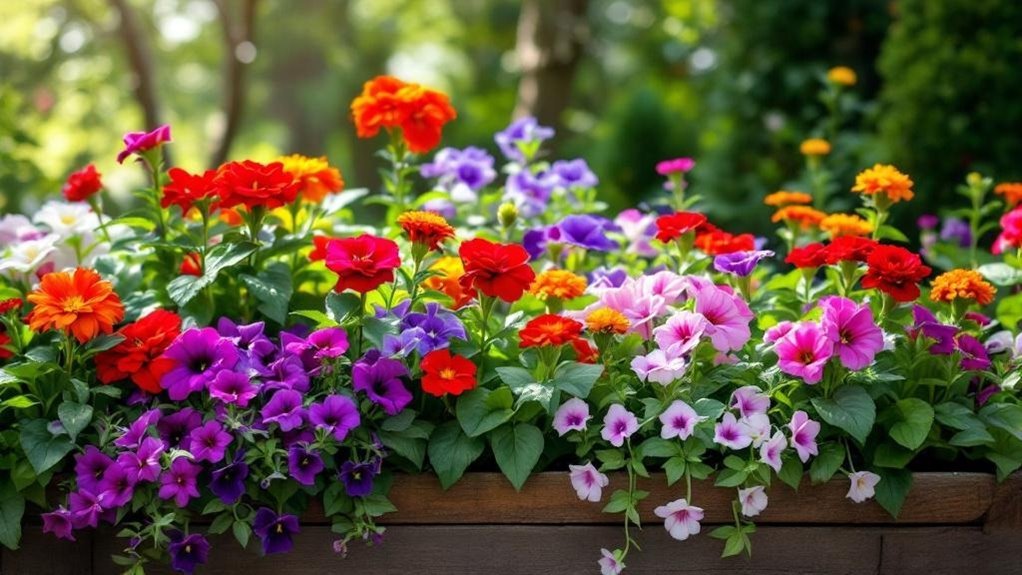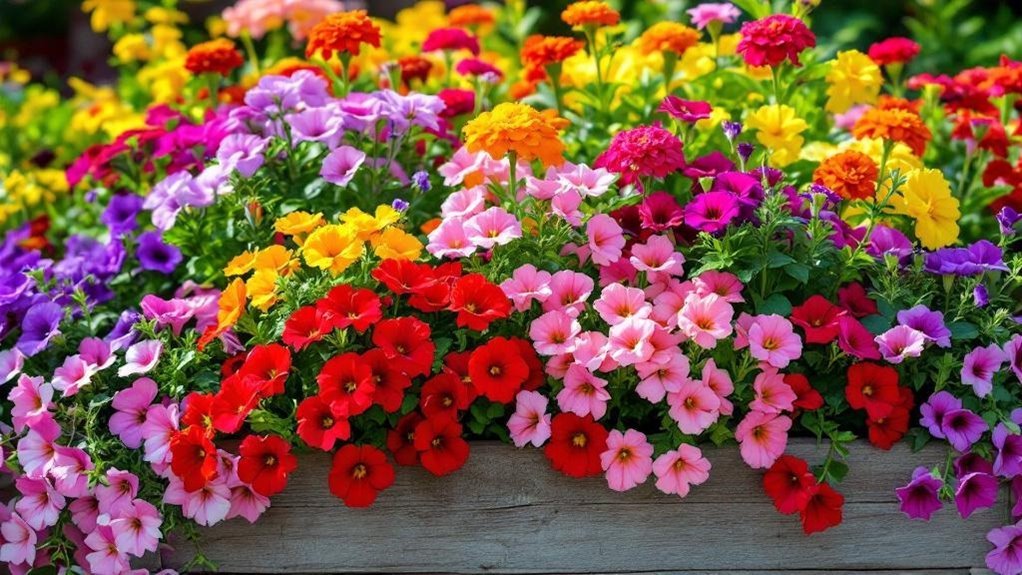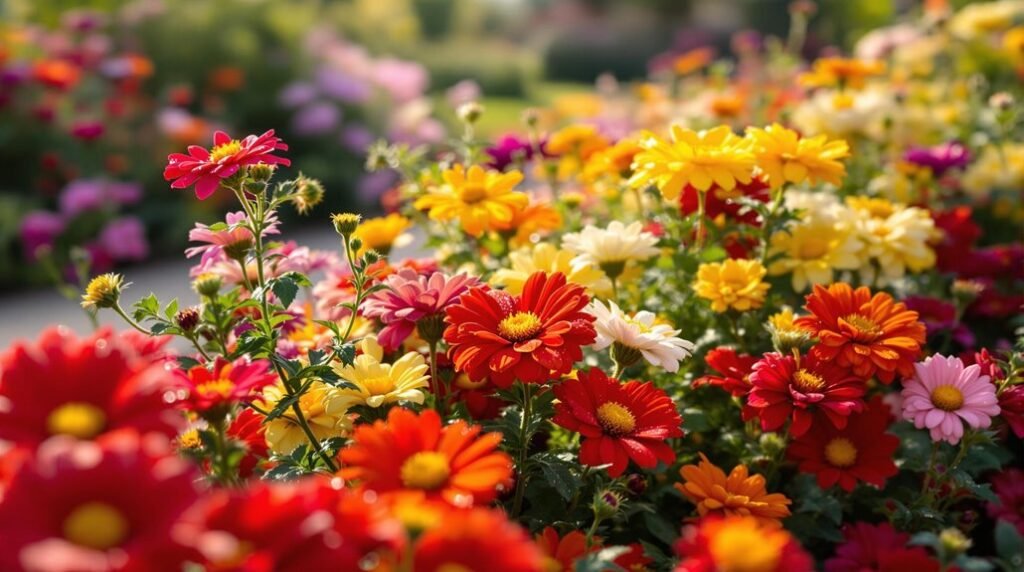Imagine stepping into your garden and being greeted by a vivid splash of reds, yellows, and purples that brighten every corner. If you want to transform your outdoor space quickly and effectively, annual flowers are your go-to solution. They’re perfect for adding instant color and variety, adapting well to different spots in your garden. But how do you choose the right ones and keep them thriving throughout the season?
Benefits of Using Annual Flowers in Your Garden
Although annual flowers complete their life cycle within a year, they offer vibrant, immediate color that can transform your garden from spring through frost.
Annual flowers bring vibrant, immediate color that brightens your garden from spring until the first frost.
When you plant annual flowers, you enjoy instant gratification as many varieties, like petunias and marigolds, are quick to grow and bloom in just 50-60 days. Their continuous blooms provide long-lasting visual appeal, keeping your garden beds lively throughout the warm season.
You can easily refresh your garden each year, experimenting with different vibrant colors and species to maintain excitement and variety. This flexibility lets you tailor your outdoor space to your mood or events without long-term commitment.
Using annual flowers guarantees your garden stays dynamic and inviting with minimal effort.
Selecting Annuals for Full Sun Locations
When you choose annuals for full sun locations, you’ll want plants that thrive with at least six hours of direct sunlight each day.
These annuals deliver vibrant blooms and colorful flowers that brighten your garden while tolerating heat. To keep them flourishing, focus on regular watering and proper feeding. Selecting varieties that attract pollinators adds life and movement to your outdoor space.
Consider these tips for ideal results:
- Pick heat-tolerant annuals like Lantana, Vinca, and SunPatiens.
- Use Petunias or Calibrachoa for containers and hanging baskets.
- Water consistently to maintain vibrant blooms.
- Apply water-soluble fertilizer every 2–3 weeks.
- Mulch around plants to conserve moisture and suppress weeds.
With these choices, your full sun garden will burst with color all season long.
Choosing Annuals for Partial Shade Areas

If your garden has spots that receive less than six hours of direct sunlight, you’ll find plenty of vibrant annuals that thrive in partial shade.
Annuals for instant color like Impatiens flourish in moist soil and come in a variety of bright colors, perfect for garden beds and containers.
Coleus adds bold, patterned foliage and adapts well to partial shade, giving you versatility for different garden spots.
Compact Begonias bring thick stems and large flowers without the need for deadheading, ideal for edging and container planting.
Don’t forget Caladiums, whose dramatic heart-shaped leaves brighten shady areas with unique textures.
Popular Annual Flowers for Containers and Hanging Baskets
Choosing the right annual flowers can instantly brighten your containers and hanging baskets with vibrant colors and varied textures.
The perfect annual flowers bring vibrant colors and textures that instantly brighten containers and hanging baskets.
For full sun spots, select annuals that thrive with minimal care and deliver eye-catching blooms. Here are five popular choices that suit containers and hanging baskets perfectly:
- Petunias: Vibrant, trailing flowers that flourish in full sun and need low maintenance.
- Calibrachoa (Superbells): Abundant blooms requiring at least 4 hours of sun and well-drained soil.
- Lantana: Heat-loving clusters that attract butterflies and thrive in sunny containers.
- Angelonia: Upright spikes that bloom continuously, ideal for sunny containers.
- Sweet Alyssum: Fragrant, low-growing flowers for part to full sun, perfect for baskets.
These annuals provide instant color, making your outdoor spaces lively and vibrant with minimal effort.
Color Combinations and Design Ideas With Annuals

Although selecting annuals is important, combining their colors thoughtfully transforms your garden into a vibrant masterpiece. Use complementary color combinations like marigold yellow with petunia purple for striking contrast. For a cohesive look, group annuals by shades—various zinnia hues work wonders. Mix heights, placing tall sunflowers behind low sweet alyssum, creating depth. Add cascading trailing annuals such as calibrachoa in hanging baskets to soften edges. Apply the “thriller, filler, spiller” design: tall angelonia (thriller), mid-height impatiens (filler), and trailing lobelia (spiller) for dynamic containers. Here’s a simple design guide:
| Role | Plant Example | Effect |
|---|---|---|
| Thriller | Angelonia | Height, focal |
| Filler | Impatiens | Mid-height fill |
| Spiller | Lobelia | Cascading edge |
This approach guarantees your garden bursts with vibrant color and engaging design.
Soil Preparation and Planting Tips for Annuals
Creating stunning color combinations is just the start—getting your soil ready and planting annuals correctly sets the foundation for their vibrant growth.
Beautiful colors begin with well-prepared soil and proper planting techniques for lasting, vibrant annuals.
To guarantee your plants thrive, focus on preparing well-drained soil that supports healthy root growth and moisture retention. Here’s how to plant annuals effectively:
- Mix 50% Back to Earth™ Composted Cotton Burrs with 50% existing soil to boost nutrients and drainage.
- For clay soil, add 10% Soil Menders™ Expanded Shale to improve drainage and root growth.
- Dig holes twice as wide as root balls to allow roots to expand comfortably.
- Plant annuals at or slightly above soil level to prevent crown rot.
- Firmly tamp down soil around roots to eliminate air pockets and keep the soil moist for better contact.
These steps create the ideal environment for your annuals to flourish.
Watering and Fertilizing Annual Flowers
Once you’ve planted your annual flowers, watering them immediately until the soil is saturated helps establish strong roots.
To keep the soil moist, water annual flowers regularly, aiming for consistent watering without overdoing it. Check soil moisture often and use soaker hoses or surface watering to avoid wetting foliage.
Fertilize with Dr. Earth Bud & Bloom Booster every four weeks, following label instructions to promote healthy growth and continuous blooming. During active growth or signs of nutrient deficiency, supplement with a foliar spray like Miracle-Gro for quick feeding.
Planted in full sun to partial shade, these annual flowers respond best to steady watering and fertilization, ensuring vibrant color throughout the season and a thriving garden that delights all summer long.
Deadheading and Maintenance for Prolonged Blooming
Keeping your annual flowers well-watered and nourished sets the stage for vibrant blooms, but maintaining that color takes a bit more effort.
Deadheading, or removing spent flowers, encourages your annuals to bloom all season by redirecting energy from seed production to new flower growth. Regular deadheading promotes prolonged blooming and maintains a tidy garden appearance.
While some varieties like Supertunia need little deadheading, most benefit greatly from this simple practice.
To keep your garden vibrant:
- Remove spent flowers promptly to encourage new blooms
- Deadhead petunias, verbenas, zinnias, and cosmos regularly
- Pinch leggy growth to maintain shape
- Check for any diseased or damaged foliage
- Use clean tools to prevent disease spread
This routine guarantees your annuals deliver color from planting through fall.
Troubleshooting Common Issues With Annuals
Many gardeners face common challenges when growing annual flowers, but you can tackle these issues effectively with some careful observation and timely action. Guarantee your flowering annuals thrive in full sun and well-draining soil to avoid root rot. Monitor for pests like aphids regularly and deadhead spent blooms to encourage continuous flowering. Watch for nutrient deficiencies, such as yellowing leaves, and maintain consistent moisture without waterlogging, especially in containers. Additionally, ensuring proper nutrient composition is key to promoting healthy growth in your annuals.
| Issue | Cause | Solution |
|---|---|---|
| Wilting or yellow leaves | Nutrient deficiencies | Adjust fertilization |
| Poor blooming | Lack of deadheading | Remove spent flowers |
| Pest damage | Aphids, spider mites | Early pest control |
| Root rot | Overwatering, poor drainage | Use well-draining soil, water consistently |
Extending the Bloom Season With Successive Plantings
After addressing common problems with your annuals, you can take your garden’s color to the next level by planning successive plantings.
By staggering planting dates, you’ll enjoy continuous color throughout the growing season. Start with cool-season annuals like pansies in early spring, then shift to warm-season blooms such as marigolds after the last frost.
Stagger plantings from cool-season pansies to warm-season marigolds for nonstop garden color all season long.
To maximize bloom time, mix early, mid, and late bloomers. Don’t forget to deadhead spent flowers regularly; this simple step encourages new growth, prolonging the blooming period.
Using a gardening calendar helps you schedule planting dates efficiently, avoiding gaps in color.
- Stagger planting dates for extended bloom time
- Combine cool- and warm-season annuals
- Plant early, mid, and late bloomers
- Deadhead spent flowers to boost blooms
- Track progress with a gardening calendar
Frequently Asked Questions
What Annual Flowers Grow in Full Shade?
You’ll find impatiens, begonias, coleus, caladiums, and wishbone flowers thrive in full shade. They brighten shady spots with vibrant blooms or colorful foliage, requiring minimal care so you can enjoy a lively garden effortlessly.
What Is the Fastest Growing Annual Flower?
You might expect patience grows flowers, but zinnias defy that—they bloom in about 60 days, faster than many. If you want rapid color, plant zinnias; they’re your quickest route to vibrant blossoms.
What Are the Colorful Annual Flowers That Bloom All Summer?
You’ll love petunias, lantanas, and zinnias for colorful, summer-long blooms. Cosmos and sunflowers also brighten your garden continuously. These flowers thrive in full sun and keep your garden vibrant without much fuss.
What Are the Best Annual Flowers for Garden Beds?
Imagine your garden bed bursting with vibrant petunias, fiery marigolds, or cheerful zinnias. You’ll love lantanas’ heat tolerance and impatiens’ shade-loving charm. These tough, colorful annuals thrive, adding beauty to every corner you plant.
Final Thoughts
With annual flowers, you hold the power to paint your garden in bursts of color all season long. You’ll watch blooms brighten your space, lift your spirits, and invite smiles with every glance. So plant, water, and care with confidence—because each flower is a promise of joy, a splash of beauty, and a dance of nature’s finest hues. Don’t wait—let your garden tell its colorful story, one vibrant bloom at a time!
